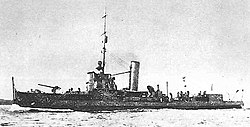Pelican (ship, 1916)
|
||||||||||||||||||
The Pelikan (until 1929 M 28 and from 1940 M 528 ) was a minesweeper built and put into service for the Imperial Navy during World War I , which was later also used in the Reichsmarine and the Kriegsmarine as well as in the German mine clearance service.
Construction and technical data
The boat of the type minesweeper in 1915 ran on 6 May 1916, the Neptun shipyard in Rostock from the stack and was on 24 June 1916 as a minesweeper M 28 in service. The boats of this type were 58.20 m long and 7.30 m wide, had a draft of 2.25 m and a construction displacement of up to 513 t . M 27 to M 42 were armed with two 10.5 cm L / 45 guns. Up to 30 mines could be carried. Two triple expansion steam engines with between 1,800 and 1,890 hp allowed a top speed of 16.3 to 16.5 knots . The boats were at 14 knots cruising speed a range of 2,000 nautical miles .
career
The boat served in the Imperial Navy in mine search and escort service and after the end of the war in the Reich Navy again in mine search and clearing service. In September 1927 it was assigned as a test ship to the Sperrversuchskommando (SVK) in Kiel-Wik and then renamed Pelikan on March 11, 1929 .
During the German invasion of Poland on September 1, 1939, the Pelikan was , together with the four other test boats of the blocking test commandos ( Arkona , Nautilus , Otto Braun and Sundevall ), part of the naval forces, which was led by Captain Friedrich Ruge , the leader of the minesweepers East (FdMO), carried out mine search and security tasks in the Gdańsk Bay . On September 19, the boat - together with the boats M 3 , M 4 , Nettelbeck , Fuchs , Sundevall , Otto Braun , Arkona , Nautilus and Drache and the ship of the line Schleswig-Holstein - was at the bombardment of the Polish positions near Gdynia (Oxhöfter Kämpe, Ostrowogrund and Hexengrund), which could only then be conquered by army soldiers.
When the Kriegsmarine needed every available ship in April 1940 to transport the German invasion troops to Norway and Denmark at the Weser Exercise Company , the Pelikan belonged to Warship Group 7 , which departed from Kiel on the morning of April 9th and left the Danish ferry ports Nyborg on Fyn and Korsör occupied on Zealand . The warship group 7 consisted of the liner Schleswig-Holstein , whose commander, sea captain Gustav Kleikamp , commanded the group, the three test boats Claus von Bevern , Nautilus and Pelikan , the transporters Campinas (4541 GRT) and Cordoba (4611 GRT), two Tugs and the BSO school flotilla with six converted fish steamers. The three test boats transported a company from Infantry Regiment 326 ( 198th Infantry Division ) and a small radio relay from Intelligence Department 235 to Nyborg, which occupied the port there.
Since the Navy had put the 3264 BRT refrigerated ship Pelikan (ship, 1934) of the African Frucht-Compagnie (parent company F. Laeisz ) into service with the torpedo test command in Kiel as a torpedo clearing ship in June 1940, the boat that remained with the SVK was transferred to the SVK to avoid mix-ups , renamed to M 528 on October 1, 1940 . In March 1945 the boat was combined with the other remaining sister boats to form the newly formed 40th minesweeping flotilla in Skagen , which carried out escort and security services in the Skagerrak and Kattegat .
After the end of the war, the 40th minesweeping flotilla with M 528 from July 27, 1945 to October 1947 was subordinated to the 3rd Mine Clearance Division of the German Mine Clearance Service , which was stationed in Copenhagen and responsible for Danish waters . After completing this task, the boat was handed over to the Office of Military Government for Germany (OMGUS) on October 28, 1947 as US spoils of war . It was then used as a residential ship at the Seebeck shipyard in Bremerhaven until September 1949 and was finally demolished in 1950.
Footnotes
- ↑ The other boats of the type had three 8.8 cm L / 30 guns ( http://www.german-navy.de/hochseeflotte/ships/minehunters/m1915/ships.html ).
- ↑ http://www.wlb-stuttgart.de/seekrieg/39-08.htm#SEP
- ↑ http://www.wlb-stuttgart.de/seekrieg/39-08.htm#SEP
- ↑ Historia Gdyni , section Wybuch Wojny - Okupacja - Wyzwolenie
- ↑ http://www.wlb-stuttgart.de/seekrieg/40-04.htm
- ↑ Oliver Krauss: Armament and armament testing in German naval history with special consideration of the Torpedoversuchsanstalt (TVA). Dissertation, Christian-Albrechts-Universität Kiel, 2006, p. 426
- ↑ http://www.wlb-stuttgart.de/seekrieg/40-04.htm
- ↑ Such renaming was carried out at this time with practically all remaining boats of the types minesweeper 1915 and minesweeper 1916 .
- ↑ http://www.wlb-stuttgart.de/seekrieg/minen/mrdiv3-frames.htm
- ↑ German: Office of the Military Government for Germany (United States)
